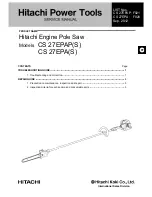
29
OPERATION
NON-THROUGH CUT
BLADE
GUARD
REMOVED
TO MAKE A NON-THROUGH CUT
See Figure 32.
Non-through cuts can be made with the grain (ripping) or
across the grain (cross cut). The use of a non-through cut
is essential to cutting grooves.
DO NOT perform bevel non-
through cuts on this machine.
NOTE: This is the only type of cut that is made without the
blade guard assembly installed. Make sure the blade guard
assembly is reinstalled upon completion of this type of cut.
DO NOT install dado blades on this machine.
Read the appropriate section which describes the type
of cut in addition to this section on non-through cuts. For
example, if your non-through cut is a straight cross cut, read
and understand the section on straight cross cuts before
proceeding.
WARNING:
When making a non-through cut, the cutter is covered
by the workpiece during most of the cut. Be alert to the
exposed cutter at the start and finish of every cut to avoid
the risk of serious personal injury.
WARNING:
Never feed wood with your hands when making any non-
through cut such as rabbets. To avoid personal injury, al-
ways use push blocks, push sticks, and featherboards.
Unplug the saw.
Remove the blade guard assembly by removing the two
socket head cap screws, lock washers, and flat washers.
Set the blade to 0º.
Set the blade to the correct depth for the workpiece.
Plug the saw into the power source.
Turn the saw
ON.
Feed the workpiece into the blade.
NOTE: Always use push blocks, push sticks, and
featherboards when making non-through cuts to avoid
the risk of serious injury.
When the cut is made, turn the saw
OFF. Wait for the
blade to come to a complete stop before removing any
part of the workpiece.
Once all non-through cuts are complete:
Unplug the saw.
Lower the blade and reinstall the blade guard assembly
using the two socket head cap screws, lock washers,
and flat washers.
Fig. 32
PUSH
STICK






































